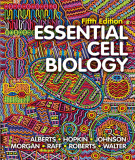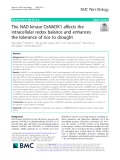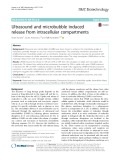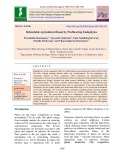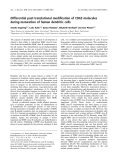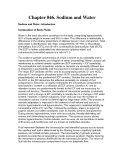
Intracellular compartments
-
Part 2 book "Essential cell biology" includes content: Membrane structure, transport across cell membranes, how cells obtain energy from food, energy generation in mitochondria and chloroplasts, intracellular compartments and protein transport, cell signaling, cytoskeleton, the cell division cycle, sexual reproduction and genetics, cell communities: tissues, stem cells and cancer.
 467p
467p  muasambanhan08
muasambanhan08
 01-03-2024
01-03-2024
 3
3
 1
1
 Download
Download
-
Part 2 book "Alberts - Essential cell biology" includes content: Membrane structure; transport across cell membranes; how cells obtain energy from food; energy generation in mitochondria and chloroplasts; intracellular compartments and protein transport; cell signaling; cytoskeleton; the cell division cycle chapter 19 sexual reproduction and the power of genetics; cell communities - tissues, stem cells, and cancer
 480p
480p  muasambanhan01
muasambanhan01
 13-12-2023
13-12-2023
 4
4
 2
2
 Download
Download
-
Part 2 book "Molecular biology of the cell" includes content: Membrane structure; membrane transport of small molecules and the electrical properties of membranes; intracellular compartments and protein sorting; intracellular membrane traffic; energy conversion: mitochondria and chloroplasts; cell signaling; the cytoskeleton; the cell cycle; cell death
 866p
866p  oursky02
oursky02
 06-08-2023
06-08-2023
 6
6
 3
3
 Download
Download
-
The physiological and hemato-biochemical changes were recorded at 15, 30, and 60 minutes after immobilization with XZT (group A) and DexMZT (group B) in six sloth bears of each group. Significant physiological difference in heart rate between the groups at 30 minutes was observed which could be due to α 2 agonist mediated biphasic cardiovascular response causing bradycardia. Significant decrease in hemoglobin concentration at 30 minutes in group B could be attributed to α 2 agonist influencing shifting of fluids from extracellular to intracellular compartments.
 5p
5p  nguaconbaynhay6
nguaconbaynhay6
 23-06-2020
23-06-2020
 12
12
 1
1
 Download
Download
-
NAD kinases (NADKs) are the only known enzymes that directly phosphorylate NAD(H) to generate NADP(H) in different subcellular compartments. They participate in multiple life activities, such as modulating the NADP/NAD ratio, maintaining the intracellular redox balance and responding to environmental stresses.
 19p
19p  viharuno2711
viharuno2711
 21-04-2020
21-04-2020
 9
9
 1
1
 Download
Download
-
Ultrasound and microbubbles (USMB) have been shown to enhance the intracellular uptake of molecules, generally thought to occur as a result of sonoporation.
 12p
12p  vihamax2711
vihamax2711
 21-04-2020
21-04-2020
 12
12
 1
1
 Download
Download
-
Endophytes are the organisms that live within plant tissues and spend at least a half of their life time without causing disease under any circumstances. So, the endophytes are commonly defined as those organisms whose infections are inconspicuous and symptomless in host tissue and internal microbial colonization. Both prokaryote (bacteria) and eukaryotes (fungi) colonize the plant tissues exhibiting a little variation in their colonization mode. The former colonize intracellularly in vascular tissues and the later shows asymptomatic colonization either inter or intracellularly.
 12p
12p  kethamoi2
kethamoi2
 15-12-2019
15-12-2019
 14
14
 0
0
 Download
Download
-
The capacity of dendritic cells to initiate T cell responses is related to their ability to redistribute MHC class II mole-cules from the intracellular MHC class II compartments to the cell surface. This redistribution occurs during dendritic cell development as they are converted from an antigen capturing, immature dendritic cell into an MHC class II-peptide presenting mature dendritic cell. During this matu-ration, antigen uptake and processing are down-regulated and peptide-loaded class II complexes become expressed in a stable manner on the cell surface. ...
 9p
9p  fptmusic
fptmusic
 16-04-2013
16-04-2013
 42
42
 1
1
 Download
Download
-
The placental leucine aminopeptidase (P-LAP)/oxytocinase is amembrane-bound enzyme thought to play an important role during pregnancy.In this study, we identified the pres-ence of P-LAP protein in the renal distal tubules and col-lecting ducts.In rat NRK52E cells derived from renal tubules, P-LAP was localized mainly in the intracellular compartment.Upon the treatment of cells with 8-arginine-vasopressin (AVP), a significant increase in the surface level of P-LAP was observed.
 7p
7p  fptmusic
fptmusic
 16-04-2013
16-04-2013
 23
23
 2
2
 Download
Download
-
Several protein toxins, such as the potent plant toxin ricin, enter mamma-lian cells by endocytosis and undergo retrograde transport via the Golgi complex to reach the endoplasmic reticulum (ER). In this compartment the catalytic moieties exploit the ER-associated degradation (ERAD) pathway to reach their cytosolic targets. Bacterial toxins such as cholera toxin or Pseudomonasexotoxin A carry KDEL or KDEL-like C-terminal tetrapep-tides for efficient delivery to the ER.
 13p
13p  fptmusic
fptmusic
 12-04-2013
12-04-2013
 42
42
 2
2
 Download
Download
-
The class III sugar transport facilitator GLUT8 co-localizes with the lyso-somal protein LAMP1 in heterologous expression systems. GLUT8 carries a [D⁄E]XXXL[L⁄I]-type dileucine sorting signal that has been postulated to retain the protein in an endosomal⁄lysosomal compartment via interactions with clathrin adaptor protein (AP) complexes.
 15p
15p  vinaphone15
vinaphone15
 25-02-2013
25-02-2013
 39
39
 1
1
 Download
Download
-
The bradykinin B2 receptor is coupled to G protein Gq⁄ 11 and becomes sequestered into intracellular compartments after activation. To more clo-sely define the receptor sequences involved in these processes and their functions, we systematically mutated all three intracellular loops (ICLs), either as point mutations or in groups of three to five amino acids to Ala, obtaining a total of 14 mutants.
 13p
13p  viettel02
viettel02
 22-02-2013
22-02-2013
 36
36
 2
2
 Download
Download
-
Differential subcellular compartmentalization of the three main Ras isoforms (H-Ras, N-Ras and K-Ras) is believed to underlie their biological differences. Modulatable interactions between cellular membranes and Ras C-terminal hypervariable region motifs determine differences in trafficking and the relative proportions of each isoform in cell-surface signalling nanoclusters and intracellular endoplasmic reticulum⁄Golgi, endosomal and mitochondrial compartments.
 9p
9p  viettel02
viettel02
 22-02-2013
22-02-2013
 35
35
 1
1
 Download
Download
-
At the beginning of the 21st century, medicine is increasingly based on understanding the functions of genes and the molecular mechanisms of diseases. In pancreatology, the understanding of functions and dysfunctions of the exocrine and endocrine pancreas is derived from molecular biological data on the actions of compounds in subcellular compartments and intracellular transcription pathways.
 523p
523p  hyperion75
hyperion75
 18-01-2013
18-01-2013
 51
51
 7
7
 Download
Download
-
Sodium and Water: Introduction Composition of Body Fluids Water is the most abundant constituent in the body, comprising approximately 50% of body weight in women and 60% in men. This difference is attributable to differences in the relative proportions of adipose tissue in men and women. Total body water is distributed in two major compartments: 55–75% is intracellular [intracellular fluid (ICF)], and 25–45% is extracellular [extracellular fluid (ECF)]. The ECF is further subdivided into intravascular (plasma water) and extravascular (interstitial) spaces in a ratio of 1:3.
 35p
35p  socolanong
socolanong
 25-04-2012
25-04-2012
 44
44
 4
4
 Download
Download
-
Harrison's Internal Medicine Chapter 46. Fluid and Electrolyte Disturbances Sodium and Water Sodium and Water: Introduction Composition of Body Fluids Water is the most abundant constituent in the body, comprising approximately 50% of body weight in women and 60% in men. This difference is attributable to differences in the relative proportions of adipose tissue in men and women. Total body water is distributed in two major compartments: 55–75% is intracellular [intracellular fluid (ICF)], and 25–45% is extracellular [extracellular fluid (ECF)].
 5p
5p  ongxaemnumber1
ongxaemnumber1
 29-11-2010
29-11-2010
 83
83
 8
8
 Download
Download
CHỦ ĐỀ BẠN MUỐN TÌM








